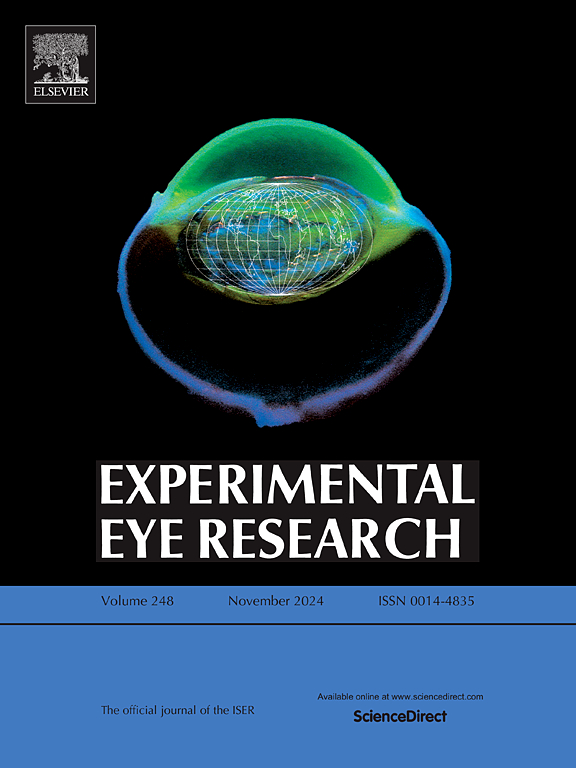探讨Graves眼病共刺激基因多态性与临床表现的关系。
IF 3
2区 医学
Q1 OPHTHALMOLOGY
引用次数: 0
摘要
格雷夫斯眼病(GO)是一种自身免疫性疾病,约30%的格雷夫斯病患者会影响眼眶组织。单核苷酸多态性(snp),特别是免疫相关基因,在氧化石墨烯的发展中起着至关重要的作用。本研究探讨了共刺激分子中的snp与氧化石墨烯特异性临床特征(包括偏侧、眼眶疼痛、肿胀、复视、突出眼、发红和眼睑收缩)之间的关系。分析了41例新诊断为GO的患者。从他们的血液中提取基因组DNA,用PCR扩增98个snp并测序。根据前期研究筛选出候选snp,采用卡方检验和遗传模型分析与临床表现相关的基因型和等位基因频率差异。发现CD28 snp rs3181096 (C vs. T: p=0.001)和rs3181098 (G vs. A: p=0.002)对眼睑炎症具有保护作用,而rs200353921的A等位基因(p=0.005)增加了眼睑炎症的风险。PDCD1 snp rs36084323 (C vs. T: p=0.004)和rs41386349 (G vs. A: p=0.005)分别与复视和眼睑炎症有关。PDCD1中rs6705653的t等位基因增加了复视的风险(p=0.001),但降低了眼睑缩回的风险(p=0.002)。其他snp包括rs2227982 (p=0.003)和rs2227981 (G vs. A: p=0.001)也与复视和眼睑缩回相关,这突出了GO临床表现的复杂遗传影响。此外,年龄、性别和snp之间的相互作用与氧化石墨烯临床特征有关。这些发现强调了这些基因在影响氧化石墨烯免疫反应和眼眶炎症中的潜在调节作用。了解这些遗传影响可以帮助确定GO管理的预测标记和新的治疗靶点。本文章由计算机程序翻译,如有差异,请以英文原文为准。
Exploring the link between Co-stimulatory gene polymorphisms and clinical manifestations in Graves' ophthalmopathy
Graves' ophthalmopathy (GO) is an autoimmune disorder that affects orbital tissues in approximately 30 % of Graves' disease patients. Single nucleotide polymorphisms (SNPs), particularly in immune-related genes, play a crucial role in the development of GO. This study investigates the association between SNPs in co-stimulatory molecules and specific clinical characteristics of GO, including laterality, orbital pain, swelling, diplopia, exophthalmos, redness, and eyelid retraction. Forty-one patients newly diagnosed with GO were analyzed. Genomic DNA was extracted from their blood, and 98 SNPs were amplified using PCR and sequenced. Candidate SNPs, selected based on prior research, were analyzed using chi-square tests and genetic models to assess genotype and allele frequency differences related to clinical manifestations. CD28 SNPs rs3181096 (C vs. T: p = 0.001) and rs3181098 (G vs. A: p = 0.002) were found to show protective effects against eyelid inflammation, while the A-allele of rs200353921(p = 0.005) increased the risk of eyelid inflammation. PDCD1 SNPs rs36084323 (C vs. T: p = 0.004) and rs41386349 (G vs. A: p = 0.005) were linked to diplopia and eyelid inflammation, respectively. The T-allele of rs6705653 in PDCD1 was found to increase the risk of diplopia (p = 0.001) but decreased the risk of eyelid retraction (p = 0.002). Other SNPs, including rs2227982 (p = 0.003) and rs2227981 (G vs. A: p = 0.001), were also associated with diplopia and eyelid retraction, highlighting the complex genetic influences on the clinical manifestations of GO. Furthermore, interactions between age, gender, and SNPs were observed in relation to GO clinical features. These findings highlight the potential regulatory roles of these genes in influencing immune responses and orbital inflammation in GO. Understanding these genetic influences could help identify predictive markers and novel therapeutic targets for GO management.
求助全文
通过发布文献求助,成功后即可免费获取论文全文。
去求助
来源期刊

Experimental eye research
医学-眼科学
CiteScore
6.80
自引率
5.90%
发文量
323
审稿时长
66 days
期刊介绍:
The primary goal of Experimental Eye Research is to publish original research papers on all aspects of experimental biology of the eye and ocular tissues that seek to define the mechanisms of normal function and/or disease. Studies of ocular tissues that encompass the disciplines of cell biology, developmental biology, genetics, molecular biology, physiology, biochemistry, biophysics, immunology or microbiology are most welcomed. Manuscripts that are purely clinical or in a surgical area of ophthalmology are not appropriate for submission to Experimental Eye Research and if received will be returned without review.
 求助内容:
求助内容: 应助结果提醒方式:
应助结果提醒方式:


